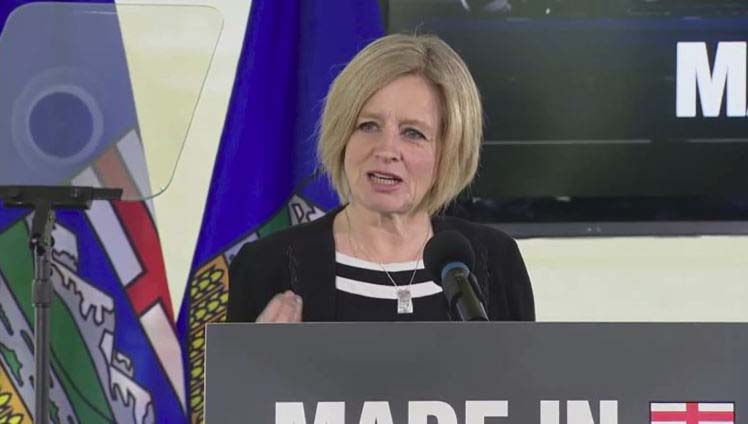
Edmonton Alberta - On 19 Feb 2019 the Alberta government announced that it had entered into transportation (and some logistics) contracts
with CN and CP to begin to move Canadian oil sands crude from the Albertan province down to the Gulf of Mexico.
The province intends to move 20,000 barrels per day (BPD) by rail beginning in July 2019, increasing to a total number of 120,000 BPD by midyear
2020.
The Alberta order to buy or lease tank cars to facilitate moving crude to points of sale would hypothetically eat away the current oversupply, stabilize
prices, and encourage growth.
Crude producers, now having a committed and consistent method of off-take, could continue expansion.
After a period of time, between pipeline expansion and rail franchise expansion, Alberta would be able to move crude with ease.
Slick!
When this plan was first announced, Alberta talked about leasing up to 7,000 tankcars, and for the most part there were "crickets."
The announcement acquired an emotional feeling similar to what happened after BNSF's dramatic 2014 announcement that it would order 5,000 new DOT 117J tankcars
for hauling Bakken crude.
It was like a threatened punishment by a middle-school parent that wants to take away an iPad but can't because it is used for "homework"
(scoff).
Then 19 Feb 2019 happened.
The number Alberta Premier Rachel Notley cited was not 7,000 tankcars but 4,400 - 1,000 retrofit DOT 117Rs and 3,400 new DOT 117Js.
The hypothetical lease term is three years, and the delivery date is going to commence in July 2019 and continue on into midyear 2020, at which point the
120,000 BPD day threshold will be achieved.
The Albertans are not doing this for free, of course.
The cost for the transportation of the crude (cars and rail and logistics) is pegged at $3.7 billion.
The government believes that will generate $5.9 billion in revenue.
As a result of this process, and after expenses (transportation, lease rates, etc.), the Albertan government expects to pocket a cool $2.2
billion.
That's not too bad for three years' worth of work.
While the "Financial Edge" is all about examining the fuzzy math involved in that $3.7 billion cost number since it makes for really interesting
copy, what raises concerns in the railcar market is what 3,400 additional DOT117J tank railcars might already do to a backlog that is already on the edge of
being overheated.
As of 31 Dec 2018 the tankcar backlog stood at 34,512 cars.
Versus historical standards, that number represents three to four years of production.
The sum of the Alberta order plus any additional orders placed in the first quarter of 2019 could easily bring the backlog up above 40,000
tankcars.
That would be the highest it has been since 2015.
For those readers new to the party, or with selective short-term memory, hyper-extended backlogs (like the one that occured from 2014 to 2015) usually end with
an oversupplied railcar market and a potentially significant market rental rate disruption.
The Canadian crude oil market has recently been an opportunistic one.
There is limited takeaway capacity, and there have been limited tankcar resources to serve the demand.
Effectively flooding the market in a short time frame with a large number of tankcars is, if history proves out, likely to cause a displacement of existing
assets working opportunistically that may not have alternative homes.
Railcar markets generally have a fragility that often goes unnoticed, as the parties involved are too close to the market to maintain perspective.
It doesn't take long for a small disconnect to become a contagion.
Additionally, the long-term prospects are far more troubling.
The cause for the Alberta tankcar purchase is a lack of alternative (e.g. pipeline) takeaway capacity.
The likelihood is that over time, and as a result of often-changing political winds, pipeline capacity will eventually be built.
Pipelines are cheaper, and their capacity to move crude oil is easily increased to a level greater than the existent crude by rail capacity.
Three years from lease commencement (roughly 2022 and 2023) 4,400 tankcars will flood the market and railcar shops and cleaning facilities.
Every lessor hopes that they will not have expiring leases competing with that block of assets.
Industry sources have not been able to confirm that an order for the cars has actually been placed, and are split on whether the order actually does get
placed.
Thus, the BNSF similarity remains apropos.
Another fine comparison might be President Trump's threats to declare a national emergency at the U.S.-Mexico border and his fixation on spending billions on
constructing a border wall.
Like with the "national emergency," immediately following Rachel Notley's announcement of the Alberta tankcar order, opposition was raised about the
business case, its viability, and justification for it.
Does this sound familiar?
In all these cases, the main similarity is that the decisions being discussed are overtly or covertly political.
Fuzzy math, politics and railcars.
It is theater of the absurd of the highest order.
David Nahass.
provisions in Section 29 of the Canadian
Copyright Modernization Act.


